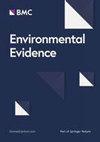苏云金芽孢杆菌(Bacillus thuringiensis israelensis, Bti)灭蚊对水生和陆地生态系统的影响
IF 5.2
4区 环境科学与生态学
Q2 ENVIRONMENTAL SCIENCES
引用次数: 0
摘要
苏云金芽孢杆菌(Bacillus thuringiensis serovar israelensis, Bti)以各种配方商业化生产,在世界范围内用作杀幼虫剂,特别是针对水生幼虫阶段的蚊子。然而,人们担心,重复的Bti处理可能对非目标生物(NTOs)及其栖息的生态系统产生直接和间接的影响。本综述评估了这些影响的证据。文献检索使用六个书目数据库、两个搜索引擎和专业网站。资格筛选分两个步骤进行(1)标题/摘要,审稿人通过双重筛选557篇文章和(2)全文来评估一致性。全文筛选后纳入的文章由两位审稿人独立进行严格评估。分歧通过讨论得以和解。纳入研究的关键参数在叙述综合表中列出,包括偏倚风险评估。meta分析比较了处理过的和未处理过的生态系统,并使用原始平均差或对数响应比作为效应大小。该综述纳入了95篇文章,涵盖282个案例研究。从中,我们确定了119个不同的反应变量,将其分为9个结果类别。大多数研究调查了NTO丰度或生活史(繁殖相关结果),但多样性和群落组成也很好地代表了结果类别。这些研究在方法论、严谨性和时空尺度上都有很大的差异,跨度从1天到21年,面积从1万平方米不等。我们的荟萃分析显示,Bti处理对手摇虫科和甲壳类动物的丰度以及手摇虫的羽化产生了一致的负面影响,尽管这些影响来自更有限的研究和地区。对于大多数剩余的响应变量,由于研究数量少或方法和结果报告不足,我们认为meta分析不可行。从我们的荟萃分析中可以明显看出,现在有大量的研究记录了使用Bti控制蚊子对NTOs或其他生态系统特性的影响,特别是与手蛾科相关的负面影响。因此,我们建议不应先验地忽视Bti处理对NTO或其他生态系统的潜在负面影响。一旦决定进行Bti治疗,就应优先考虑设计良好的持续监测和评估方案。对大多数反应变量进行低偏倚风险的严格研究的缺乏削弱了我们评估记录的许多影响可能有多普遍的能力。未来的研究将受益于一种严谨的、可充分复制的方法来研究Bti在半野外环境或野外的影响,同时在报告关键方法细节方面更加严格。我们需要更多地关注于了解控制使用Bti灭蚊对nto和生态系统的更广泛影响的环境因素,以提高我们预测Bti最有可能在何时何地产生额外的、负面的和间接的生态影响的能力。本文章由计算机程序翻译,如有差异,请以英文原文为准。
Effects of mosquito control using the microbial agent Bacillus thuringiensis israelensis (Bti) on aquatic and terrestrial ecosystems: a systematic review
The bacterium Bacillus thuringiensis serovar israelensis (Bti) is commercially produced in various formulations for use as a larvicide worldwide, targeting especially the aquatic larval stage of mosquitoes. However, there is a concern that repeated Bti treatments may have both direct and indirect impacts on non-target organisms (NTOs) and the ecosystems they inhabit. This review evaluates the evidence for such impacts. Literature was searched using six bibliographic databases, two search engines, and on specialist web sites. Eligibility screening was performed in two steps on (1) title/abstract, with consistency among reviewers assessed by double-screening 557 articles and (2) full text. Articles included after full text screening were critically appraised independently by two reviewers. Disagreements were reconciled through discussions. Key parameters of included studies are presented in narrative synthesis tables, including risk of bias assessments. Meta-analyses comparing treated with untreated ecosystems and using either the raw mean difference or log response ratio as effect size were performed. Ninety-five articles covering 282 case studies were included in the review. From these, we identified 119 different response variables, which were divided into nine outcome categories. Most studies investigated NTO abundance or life history (reproduction related outcomes), but diversity and community composition are also well represented as outcome categories. The studies are highly variable in methodology, rigor, and spatio-temporal scale, spanning 1 day to 21 years and from < 1m2 to > 10,000 m2. Our metanalyses revealed a consistent negative effect of Bti treatment on abundances of Chironomidae and Crustacea, and also on chironomid emergence, although from a more restricted set of studies and regions. For most remaining response variables, we judged meta-analysis unfeasible, due to low study numbers or insufficient reporting of methods and results. There is now a significant body of studies documenting effects of mosquito control using Bti on NTOs or other ecosystem properties, especially associated with negative effects on Chironomidae, as apparent from our meta-analyses. Accordingly, we suggest the potential for negative NTO or other ecosystem effects of Bti treatment should not be discounted a priori. Once a decision to proceed with Bti treatment has been taken, priority should be given to a well-designed program of ongoing monitoring and assessment. The paucity of rigorous studies conducted with low bias risk for most response variables undermines our capacity for evaluating how common many of the effects documented might be. Future research would benefit from a rigorous and well-replicated approach to studying Bti impacts in semi-field mesocosms or in the field, combined with a greater rigor in reporting key methodological details. A greater focus is needed on understanding the environmental factors which regulate the wider effects of mosquito control using Bti on NTOs and ecosystems, to enhance our capacity for predicting where and when Bti is most likely to have additional, negative and indirect ecological impacts.
求助全文
通过发布文献求助,成功后即可免费获取论文全文。
去求助
来源期刊

Environmental Evidence
Environmental Science-Management, Monitoring, Policy and Law
CiteScore
6.10
自引率
18.20%
发文量
36
审稿时长
17 weeks
期刊介绍:
Environmental Evidence is the journal of the Collaboration for Environmental Evidence (CEE). The Journal facilitates rapid publication of evidence syntheses, in the form of Systematic Reviews and Maps conducted to CEE Guidelines and Standards. We focus on the effectiveness of environmental management interventions and the impact of human activities on the environment. Our scope covers all forms of environmental management and human impacts and therefore spans the natural and social sciences. Subjects include water security, agriculture, food security, forestry, fisheries, natural resource management, biodiversity conservation, climate change, ecosystem services, pollution, invasive species, environment and human wellbeing, sustainable energy use, soil management, environmental legislation, environmental education.
 求助内容:
求助内容: 应助结果提醒方式:
应助结果提醒方式:


